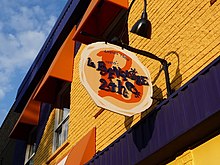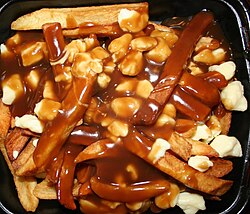Poutine: Difference between revisions
No edit summary |
m Reverted edits by 206.130.211.35 (talk) (HG 3) |
||
| Line 101: | Line 101: | ||
==Acclaim== |
==Acclaim== |
||
Montreal hosts a competitive ''Semaine de la Poutine'' (Poutine Week) every year in February.<ref>http://poutineweekmtl.com/index.eng.html</ref> Ottawa-Gatineau, Toronto, and Quebec City similarly hold 'La Poutine Week'.<ref>http://lapoutineweek.com/</ref> Calgary holds 'Poutine Week' (with no definite article).<ref>http://www.yelp.ca/topic/calgary-best-poutine-in-calgary</ref> |
|||
I am just a simple man making my poutine and my chese curds and then i GOT BRONCHUDIS |
|||
==In politics== |
==In politics== |
||
Revision as of 15:48, 10 June 2014
 Poutine | |
| Course | Main dish or side dish |
|---|---|
| Place of origin | Canada |
| Region or state | Quebec (late 1950s) |
| Created by | Multiple claims |
| Serving temperature | Hot |
| Main ingredients | French fries, thin brown gravy, cheese curds |
| Variations | Multiple |
| Part of a series on |
| Canadian cuisine |
|---|
 |
Poutine (/puːˈtiːn/; French: [putin], Quebec French:[put͡sɪn] ⓘ) is a common Canadian dish, originally from Quebec, made with french fries, topped with a light brown gravy-like sauce and cheese curds.[1] This fast food dish can now be found across Canada, and is also found in some places in the northern United States, where it is sometimes required to be described due to its exotic nature.[2] It is sold in small "greasy spoon" type diners (commonly known as cantines or casse-croûtes in Quebec) and pubs, as well as by roadside fry wagons (commonly known as cabanes à patates, literally "potato shacks"). National and international chains like New York Fries,[3] McDonald's,[4] A&W,[5] KFC,[6] Burger King,[7] and Harvey's[8] also sell mass-market poutine in Canada (although not always country-wide[9]).
Origins
The dish originated in rural Quebec, Canada, in the late 1950s. Several Québécois communities claim to be the birthplace of poutine, including Drummondville (by Jean-Paul Roy in 1964),[10] Saint-Jean-sur-Richelieu, [citation needed] and Victoriaville.[11] One often-cited tale is that of Fernand Lachance, from Warwick, Quebec, which claims that poutine was invented there in 1957;[12] Lachance is said to have exclaimed, "ça va faire une maudite poutine" ("it will make a damn mess") when asked to put a handful of curds on some french fries, hence the name. The sauce was allegedly added later, to keep the fries warm longer. Over time the dish's popularity spread mainly across the province (and later throughout Canada), often served in small town restaurants, bars, as well as being quite popular in ski resorts.
Etymology
The Dictionnaire historique du français québécois lists 15 different meanings of poutine in Quebec and Acadian French, most of which are for kinds of food; the word poutine in the meaning "fries with cheese and gravy" is dated to 1978. Other senses of the word have been in use at least since 1810.[13]
While the exact provenance of the word "poutine" is uncertain, some of its meanings undoubtedly result at least in part from the influence of the English word pudding. Among its various culinary senses, that of "a dessert made from flour or bread crumbs" most clearly shows this influence; the word pouding, borrowed from the English pudding, is in fact a synonym in this sense. The pejorative meaning "fat person" of poutine (used especially in speaking of a woman) is believed to derive from the English pudding "a person or thing resembling a pudding" or "stout, thick-set person".[14]
In other meanings of poutine, the existence of a relation to the English word pudding is uncertain. One of these additional meanings — the one from which the name of the dish with fries is thought to derive — is "unappetizing mixture of various foods, usually leftovers." This sense may also have given rise to the meaning "complicated business, complex organization; set of operations whose management is difficult or problematic."
The Dictionnaire historique mentions the possibility that the form poutine is simply a gallicization of the word pudding. However, it considers it more likely that it was inherited from regional languages spoken in France, and that some of its meanings resulted from the later influence of the similar-sounding English word pudding. It cites the Provençal forms poutingo "bad stew" and poutité "hodgepodge" or "crushed fruit or foods"; poutringo "mixture of various things" in Languedocien; and poutringue, potringa "bad stew" in Franche-Comté as possibly related to poutine. The meaning "fries with cheese and gravy" of poutine is among those held as probably unrelated to pudding provided the latter view is correct.[13]
Recipe

In the basic recipe for poutine, French fries are covered with fresh cheese curds, and topped with brown gravy. In a Quebec poutine:
- Fries: Usually of medium thickness, and fried (sometimes doubly) so that the inside stays soft, while the outside is crispy.
- Cheese curds: Fresh cheese curds are used to give the desired texture. The curd size may vary but is usually slightly smaller than bite-sized.
- Gravy: Traditionally a light and thin chicken, veal, or turkey gravy, mildly spiced with a hint of pepper, or a sauce brune which is a combination of beef and chicken stock, a variant originating in Quebec. The gravy should be thin enough to easily filter down into the mass of fries and cheese curds. These sauces typically also contain vinegar or a sour flavouring to balance the richness of the cheese and fries. Traditional poutine sauces (mélange à sauce poutine) are sold in Quebec, Ontario, and Maritime grocery stores in jars or cans and in powdered mix packets. Recently, some outlets have begun to offer vegetarian gravy as an option to cater to vegetarians.[16]
Heavy beef or pork-based brown gravies are rarely used. To maintain the texture of the fries, the cheese curd and gravy are added immediately prior to serving the dish. The hot gravy is usually poured over the cold cheese curds, so that the cheese is warmed without completely melting. It is important to control the temperature, timing and the order in which the ingredients are added, so as to obtain the right food textures which is an essential part of the experience of eating poutine.
Variations

There are many variations of poutine. Some restaurants offer poutine with such additions as chicken, bacon, or Montreal-style smoked meat. Some such restaurants even boast a dozen or more variations of poutine. For instance, more upscale poutine with three-pepper sauce, merguez sausage, foie gras[17] or even caviar and truffle can be found.[18] Some variations eliminate the cheese, but most Québécois would call such a dish a frite sauce ("french fries with sauce") rather than poutine. Shawinigan and some other regions have patate-sauce-choux where shredded raw cabbage replaces cheese. Fast food combination meals in Canada often have the option of getting french fries "poutinized" by adding cheese curds (or shredded cheese in the Prairies and Western Canada) and gravy.
Over the years, there have been many variations to this classic Canadian dish. Sweet potato, for example, has been used to be a healthy alternative to french fries. The idea of adding dietary fiber and vitamins in this classic dish is widely appraised by the public. [19]
Outside Canada, poutine is found in northern border regions of the United States such as New England, the Pacific Northwest and the Upper Midwest. These regions offer further variations of the basic dish. Cheeses other than fresh curds are commonly used (most commonly mozzarella cheese), along with beef, brown or turkey gravy. In the county culture especially, a mixed fry can also come with cooked ground beef on top and is referred to as a hamburger mix, though this is less popular than a regular mix.
class="wikitable "
Similar dishes

Chips and Gravy ("chips" being the British term for thicker French fries) is a staple of the cheaper bistro style menus, in such places as Royal Canadian Legion and Workers Clubs.[original research?]
In Newfoundland and Labrador, most non-national chain restaurants serve a traditional dish called chips, dressing and gravy (a.k.a. "Newfie fries"). "Dressing" is a mixture of mainly white bread crumbs and savoury and is often referred to as "stuffing" outside of Atlantic Canada. Chips, dressing and gravy is served much like poutine, except for the dressing substituting for the cheese. While loved by Newfoundlanders and Labradorians, the dish is not very widely known of outside the Canadian province, and within pockets of NL exiles.
In Prince Edward Island, a common dish is "Fries with the Works" which is fries with ground beef and onions, topped with thick beef gravy and fresh green peas.
Disco Fries, also known as "Elvis Fries," served in New Jersey and select New York City diners, are made with brown gravy, mozzarella, and heavier steak fries. Elsewhere in the greater New York City area and Long Island, diners serve "cheese fries," using either American (processed) cheese or mozzarella. Diners in New York, New Jersey, and Connecticut serve "gravy-cheese-fries" or even "french fries with cheese and gravy"; these are most commonly steak fries, brown gravy, and American cheese.
"Chili Cheese Fries" are served in Coney Island restaurants around Detroit, Michigan. Shoestring French Fries are covered with the hot dog sauce ("chili" sauce) unique to the Detroit area, then covered with shredded cheddar cheese. (See Coney Island (restaurant))
In Southern California, the fast food chain Tommy's has a thick, brown gravy based meat chili, and the ingredients of their chili cheese fries are comparable to those of Poutine. The chili is thicker, however, and the cheese is American cheese.
Cheese fries are also served in many diners in the American Southwest; in Texas, for example, they usually include at least one variety of grated Cheddar cheese, and are commonly served with ranch dressing and, sometimes, bacon, jalapenos and chives, whereas in New Mexico, the fries are typically served with green chili and cheese, creating a dish that combines two Southwest favorites, french fries and chile con queso. The secret menu at In-N-Out Burger includes "animal fries," a dish consisting of cheese, grilled onions, and the chain's "secret sauce" over fries. Around Chicago in Northern Illinois, up though Wisconsin and into Minnesota, cheese fries are often made using a natural cheddar spread such as Merkt's brand, which has an intense flavor and distinctive texture. Chili cheese fries are a common variation.
Boo fries (cheese, french fries and gravy) are found in New Orleans.[20]
European variations
In the United Kingdom (particularly the Isle of Man, the north of England and Scotland), the dish is simply named Chips, Cheese and Gravy.[21] The dish is common in chip shops, and other small, local fast food stores and consists of thick-cut chips, shredded cheddar cheese (and sometimes a 50/50 mix of cheddar and mozzarella cheese), topped with thick gravy. A variant is sometimes made with curry sauce instead of gravy. The dish was developed independently of poutine.[citation needed]
In the Netherlands, a dish named "kapsalon" (hair salon) consists of french fries, shawarma meats or doner kebab, and grilled gouda cheese, topped with salad, garlic sauce and sambal. The dish was invented in Rotterdam by a kebab shop owner who served it to employees of a local hair salon.[citation needed] It gained popularity and is now widely available across the Netherlands.
Cultural aspect
A cultural marker, poutine has long been Canada's 'embarrassing but adored' junk food. It served as a comfort food for the local community after the Lac-Megantic derailment.[22]
In 2007 the CBC declared the outcome of an online survey on the greatest Canadian inventions of all time. Poutine arrived at No. 10, beating, among other items, the electron microscope, the BlackBerry, and the paint roller.[23]
Poutine has been a highlight of the London, UK 'Canada Day' celebrations in Trafalgar Square for several years.[24]
However, poutine has since made inroads into proper culinary circles, challenging its junk food status. Thus in 2011, well-known chef Chuck Hughes won on Iron Chef America (episode 2 of season 9) by beating out his heavyweight competitor with a plate of lobster poutine.[25]
In 2013, Jones Soda Co. originally a Canadian company but now based in the USA created a poutine-flavored limited-edition soft drink, which got international pop culture attention.[21]
Acclaim
Montreal hosts a competitive Semaine de la Poutine (Poutine Week) every year in February.[26] Ottawa-Gatineau, Toronto, and Quebec City similarly hold 'La Poutine Week'.[27] Calgary holds 'Poutine Week' (with no definite article).[28]
In politics
In a Talking to Americans segment on the Canadian mock television news show This Hour Has 22 Minutes during the 2000 American election, comedian Rick Mercer posed as a reporter and asked several people (including then-Texas governor George W. Bush) what they thought of "Prime Minister Jean Poutine" and his endorsement of Bush for president. (The Prime Minister of Canada at the time was Jean Chrétien). None of the interviewees noticed the insertion of "Poutine." A few years later when Bush made his first official visit to Canada as President, he joked during a speech, "I told [Prime Minister] Paul [Martin] that I really have only one regret about this visit to Canada. There's a prominent citizen who endorsed me in the 2000 election, and I wanted a chance to finally thank him for that endorsement. I was hoping to meet Jean Poutine." The remark was met with laughter and applause.[29]
The name of the President of Russia, Vladimir Putin, is coincidentally transliterated as Vladimir Poutine in French.[30]
During the 2011 Canadian federal election voter suppression scandal, misleading phone calls registered to a "Pierre Poutine" of "Separatist Street" in Joliette, Quebec, were made in at least 14 ridings, including Guelph, Ontario. The fraudulent calls directed voters to the wrong polling stations.[31] Through court orders of document releases from Rogers Communications the source of the calls was eventually traced and appeared to correspond to the campaign office of Conservative Party of Canada candidate Marty Burke.[32]
See also
References
- ^ Knight, A. (11 June 2007). "Poutine 101". Knight's Canadian Info Collection. Retrieved 1 July 2011.
- ^ McGrath, Charles (21 June 2013). "In Cape Breton, a Rugged Golf Getaway". The New York Times. Retrieved 1 July 2013.
- ^ Ouellette, Jennifer (2013-07-04). "New York Fries Announces Expansion into Turkey". The Wall Street Journal. Retrieved 2013-08-05.
- ^ Day, Adam. "Oh Canada, we stand on guard for ... poutine?". The Digital Times. Kamloops, BC: Journalism Students at Thompson Rivers University. Retrieved May 19, 2008.[dead link]
- ^ "Nutritional Facts — Small Poutine". A&W Trade Marks. Retrieved 19 May 2008.
- ^ "Signature Sides". KFC. Retrieved 2013-08-05.
- ^ "Our menu — Poutine". Burger King. Retrieved 19 May 2008.[dead link]
- ^ http://harveys.ca/eng/sides.php
- ^ http://life.nationalpost.com/2013/12/03/mcdonalds-poutine-is-back-on-menus-across-canada-garnering-cheers-disbelief-from-lovers-of-the-quebec-dish/
- ^ Sekules, Kate (23 May 2007). "A Staple From Quebec, Embarrassing but Adored". The New York Times. Retrieved 19 May 2008. Article on Poutine coming to New York City
- ^ Kane, Marion (8 November 2008). "The war of the curds". The Star. Retrieved 16 December 2001.
- ^ "The 50 Inventions — Poutine". The Greatest Canadian Invention. Canadian Broadcasting Corporation. Retrieved 19 May 2008.
{{cite news}}: Unknown parameter|deadurl=ignored (|url-status=suggested) (help)[dead link] - ^ a b Poirier, Claude; Canac-Marquis, Steve (1998). Dictionnaire historique du français québécois. Université Laval. ISBN 2-7637-7557-8.
- ^ "Poutine". Base de données lexicographiques du Québec. Trésor de la langue française au Québec – Université Laval. Retrieved 19 May 2008.
- ^ "About Us". La Banquise. Retrieved 10 April 2012.
- ^ http://604now.com/2014/05/8-places-to-find-vegetarian-poutine-in-vancouver/
- ^ Koentges, Christopher (2012-10-04). "How To Make Poutine 2.0: Gravy Hacks, Cheese Curd Modification". Very Ethnic. Retrieved 2013-08-05.
- ^ Krauss, Clifford (26 April 2004). "Quebec Finds Pride in a Greasy Favorite". The New York Times. Retrieved 19 May 2008. [dead link]
- ^ Michael, Souzan. "Playful Poutine Recipes". foodnetwork. Retrieved 21 November 2013.
- ^ Food Paradise
- ^ a b "Chips, cheese and gravy-flavoured fizzy drink launched". www.bbc.co.uk. 5 May 2013. Retrieved 1 July 2013.
- ^ Loriggio, Paola (2013-07-10). "Poutine shack near Lac-Megantic derailment site sees familiar faces; some still missing (with video)". Calgary Herald. Retrieved 2013-08-05.
- ^ Sekules, Kate (23 May 2007). "A Staple From Quebec, Embarrassing but Adored". The New York Times. Retrieved 1 July 2013.
Granted, poutine came in only at No. 10. But it beat, among other things, the electron microscope, the BlackBerry, the paint roller and the caulking gun, lacrosse, plexiglass, radio voice transmission and basketball.
- ^ Perreaux, Les (5 May 2013). "Canada Day heads to the Big Apple". The Globe and Mail. Retrieved 1 July 2013.
- ^ "Quebec chef wins Iron Chef with lobster poutine". CBC News. 21 Mar 2011. Retrieved 1 July 2013.
- ^ http://poutineweekmtl.com/index.eng.html
- ^ http://lapoutineweek.com/
- ^ http://www.yelp.ca/topic/calgary-best-poutine-in-calgary
- ^ "President Discusses Strong Relationship with Canada" (Press release). 1 December 2004. Retrieved 19 May 2008.
- ^ "Putin/Poutine" (Press release). 3 April 2005. Retrieved 14 January 2013.
- ^ Kennedy, Mark (March 11, 2012). "Robocall controversy hasn't hurt support for Tories: poll". National Post. Retrieved March 11, 2012.
- ^ Postmedia News (2013-03-13). "Elections commissioner wants charges laid over 'Pierre Poutine' robocalls". National Post. Retrieved 2013-08-05.
